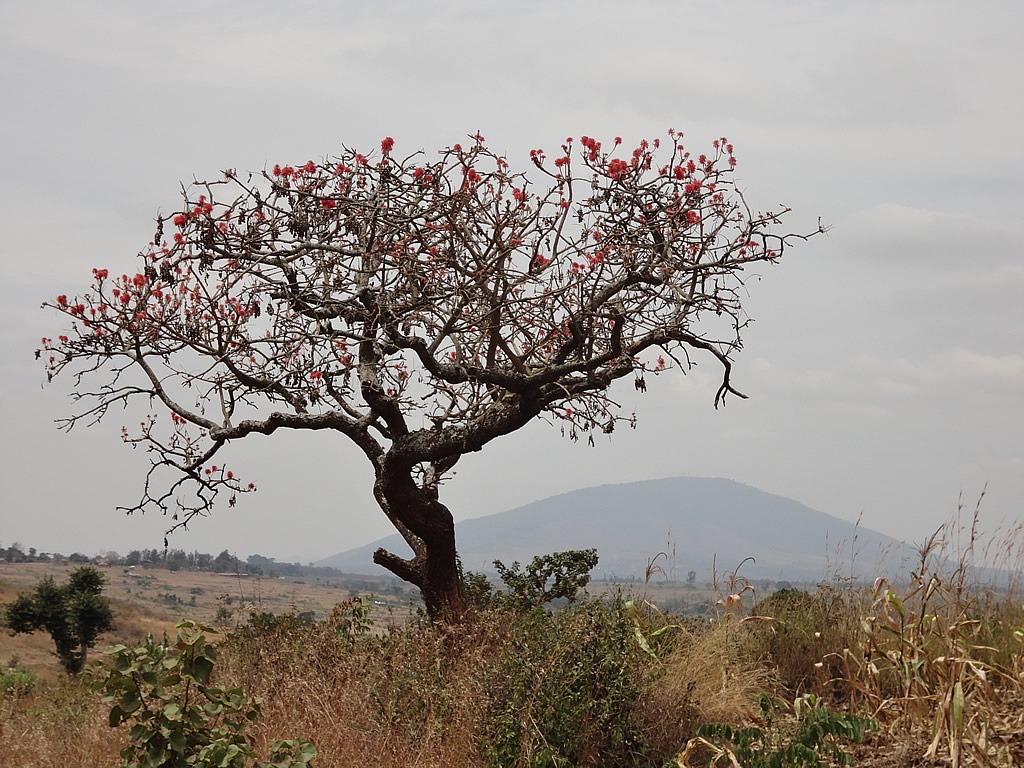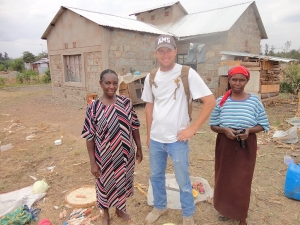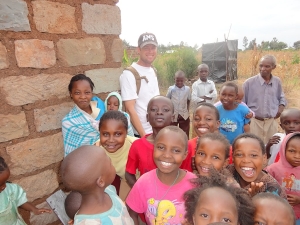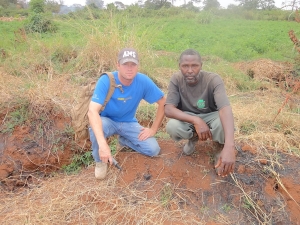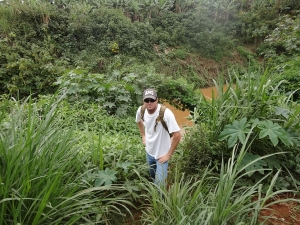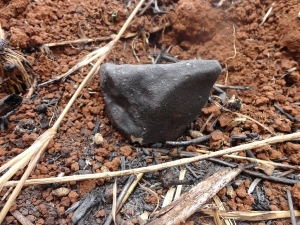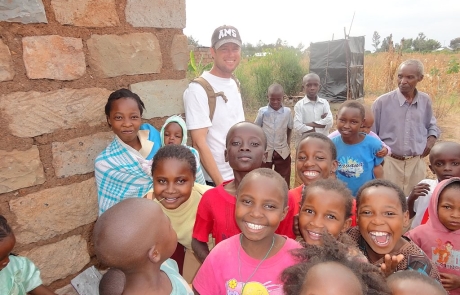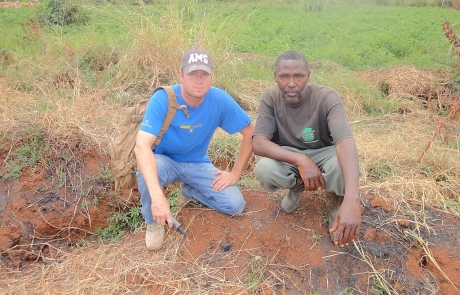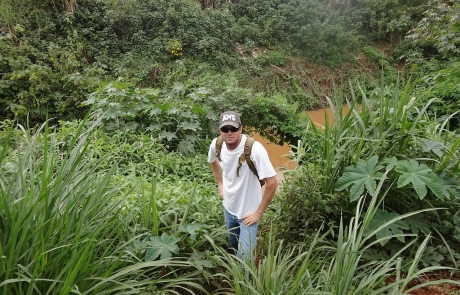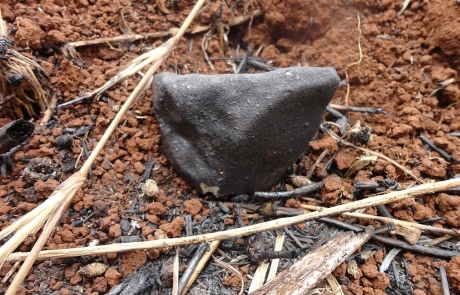Expedition Journal
Meteorites fall in Kenya Villages
On July 16, 2011, residents around Kiambu County, in the Thika District of Kenya, experienced loud explosions as a massive fireball broke into many pieces overhead.
The first news reports showed a 2 ½-kilo stone that almost struck a woman working in her field in the village of Kihumwiri. The meteorite was taken by the military to the University of Nairobi. Several other pieces were soon recovered in Mwana Wikio, and two meteorites hit greenhouses at the Kenya Cuttings nursery.
Arrival in Nairobi
I flew into Nairobi and was met by my driver at the airport. We rented a car in the city and picked a scout. It takes several hours to get out of Nairobi. Between highway construction projects and the sea of people crossing the road, it is a precarious journey.
After more than four hours of driving, we arrived in Kiambu County. Pineapple fields stretched in every direction across a vast valley. We soon found the Thika general store and began to inquire about meteorites for sale. Everybody had a story and many people knew someone who had found a meteorite. My two guys went to work getting the word out that I was in the area looking to acquire stones. While they checked out leads, I spent some time walking coffee rows in the hope of making a find.
The following day we drove to an area where a large stone had fallen in a cornfield. I interviewed the people standing nearby when the stone fell, and my interpreter described the shock and amazement they experienced, witnessing the meteor’s break up and having this large meteorite plummet to the ground and smash through the cornhusks just in front of them. There was plenty of ground that was good for hunting, and I spent the better part of the day hunting nearby pastureland.
Only a Few Fragments
On the next day, we went to the other side of the valley on the small end of the strewnfield. A small stone had landed in the courtyard of a house. We were shown where the meteorite had impacted, and I was offered several small fragments. There was a lot of searchable land in the area, so we began to recruit locals to hunt for us. And I offered a hefty reward for any pieces recovered.
We worked our way down the flight path, crossing a bridge into a tribal area between the river and Kenya Cuttings nursery. Soon I was surrounded by curious villagers and a multitude of children. It became almost impossible to hunt with this crowd following me, and one of my interpreters finally came up to me, grinning. He said, “They have never seen a Mzunga (white man) in their village before!” Having lived in Africa many times in my youth, I was used to this reaction from locals. Otherwise, it would have certainly been unnerving.
Several days passed, chasing dead-end leads and arriving at a location only to be handed a common rock. One woman told a rather intriguing story of washing clothes at the edge of a nearby lake. She heard the explosions, and seconds later something impacted the surface of the lake, perhaps 30 meters out, sending a geyser of water tens of meters into the air. I’m quite certain that her story was truthful, but considering the multitude of nasty creatures that live in African waters, I was not about to attempt a recovery.
A Sizeable Specimen Surfaces
We visited the spot where the large stone that had made headlines around the world had fallen. An old man that was standing nearby at the time told me of hearing objects screaming overhead. He pointed further down the flight path and explained to my interpreter that he saw several dark objects disappear behind the tree line in that direction. We spent considerable time hunting in the area he indicated, but no stones have been recovered that far down the flight path.
Every time we arrived in a village, people would run up and stick rocks through the window. The lack of meteorite finds was becoming a bit discouraging. Eventually, an old man walked up to my window and muttered something in my face. Opening his hand, he presented a beautiful 130-gram complete stone. My driver responded, “This the one you are looking for, yes?” I nodded my head, and my driver instructed the man to get in the back of the car.
We drove to a private area to make deal for the stone. The old man was a member of one of our search teams a few days prior. He was working in a field near the bridge crossing the river when he found this stone in his row. He drove a hard bargain, but we finally agreed upon the price of $1200 US.
I returned to my hotel in a nearby town, very pleased to finally have secured a specimen for my collection. I celebrated with my driver and scout with a few White Cap beers – “The president’s beer” – and tilapia dinners, accompanied with the traditional Kenyan dish ugali.
Mission Abort
After dinner, I headed up to the second level, where the gatekeeper smiled at me pleasantly as she opened the huge iron door. I turned around as she locked it behind me. It was a strange experience – locking yourself in a cage at night for your own safety! The required barriers of protection did not end there. As I retired to my bed, I made sure the mosquito net was carefully tucked around my bedding on all corners, for fear that malaria-bearing mosquitoes, or various deadly spiders, could find their way inside.
The following day we were approached by a man on a motorcycle who told us there was a person who had a stone and instructed us to follow him to the location. The road he took us down became ever-increasingly worse, and looking at our position on the GPS, we were clearly leaving the flight path. My driver looked back at me and shook his head, exclaiming with a worried look, “I don’t like this!” I told him that we had left the strewnfield, and he replied, “I thought so, too. Something is wrong.”
He told me that he had seen this man on the motorcycle talking with a man named Stanley – a guy who was working for Mike Farmer, who was also looking to purchase stones. On several occasions, while talking to locals, we had noticed this Stanley character. He was of unusual height and wore a red shirt so that he could not be mistaken. We immediately turned around, and I looked back to see the man on the motorcycle looking back over his shoulder with a bewildered look on his face.
Farmer’s Close Call
Several weeks later, Mike Farmer returned to Kenya at the allure of purchasing a large stone that was rumored to be available. He and his local help were parked on a remote dirt road when men surrounded the car. Wielding a gun and several machetes, they yanked the driver and scout from the vehicle, beating them both and locking them in the trunk. They drove the car to a remote area in the woods, where Mike was sure he was to meet his end. After some argument about killing them, the men told Mike to get in the driver’s seat and drive away. He began to open the rear door to get in the front but was struck in the head. He was told to climb over the seat and leave with his two guys still locked in the trunk.
After hearing this, it was clear to me what had transpired on my trip. Mike’s scout, Stanley, had been attempting to rob me while on Mike’s payroll. After realizing that this would be Mike’s last trip, Stanley organized a robbery to get all of Mike’s cash and belongings. If not for going with my gut instinct, I very well might have fallen prey to their plan and be dead right now. Kenya was a seemingly benevolent hunt, but danger and risk of death were always literally right on our heels.
IT WAS CLASSIFIED AS AN L6 ORDINARY CHONDRITE.
Meteorite Details
| Name: | Thika |
| Location: | Kiambu County, Kenya |
| Classification: | L6 |
| Witnessed: | Yes |
| Fell: | July 16, 2011 |
| TKW: | 14.2 kg |


